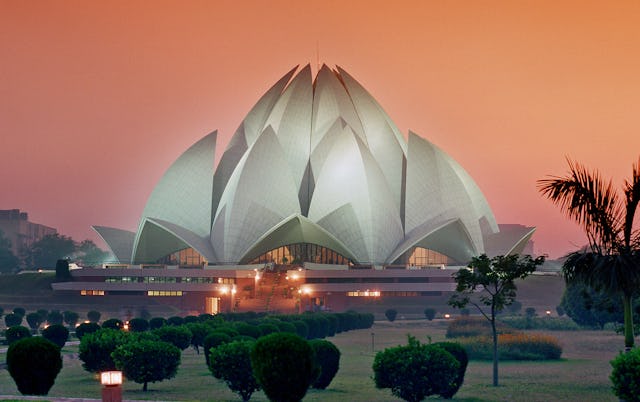Lotus temple embodies "message for the world of today"
NEW DELHI, India — On the 25th anniversary of the opening of the Baha'i House of Worship here, Delhi's Chief Minister has praised the impact the temple has made on Indian society, and beyond.
"This is a very iconic building of India. There's nothing like this anywhere else," Sheila Dikshit told the crowd attending the temple's silver jubilee festivities. "It is thanks to this temple that Delhi has also found a way to reach the hearts of millions of people all over the world."
The Chief Minister's remarks came as she paid a special visit on the final morning of a weekend-long celebratory program, at which more than 5,000 visitors from throughout the sub-continent – as well as almost 60 other countries – gathered at the temple's grounds.
"I wish I could express in words my joy," Mrs. Dikshit told the celebration. "Your message is the message for the world of today. The Baha'i Faith is the faith that teaches us all are equal. It rises above any narrow consideration of humanity."
In its message to mark the occasion, the Universal House of Justice noted the temple's "power to harmonize the manifest diversity of its visitors, to awaken nobility in hearts, and to strengthen hope for peace."
"Under the shadow of this magnificent edifice, millions who seek God have found tranquillity and been uplifted by the songs of praise and exaltation that rise from its inner sanctum," wrote the Universal House of Justice.
Greetings were also received from the President of India, Mrs. Shrimati Pratibha Devisingh Patil, and former President, Dr. A.P.J. Kalam.
"The House of Worship with its beautiful environment transmits a message on how to celebrate the differences existing in the society," Dr. Kalam wrote. "This culture of celebrating the differences in the society is the greatest contribution made by (the) Baha'i Faith to humanity."
The Baha'i House of Worship, popularly referred to as the "Lotus Temple" – because of its award-winning design inspired by a lotus flower – is one of the most visited buildings in the world. Over the past quarter of a century, it has received an average of 4.3 million visitors every year – from all nations, religions and walks of life.
Open to all people, the purpose of Baha'i Houses of Worship is to provide a central gathering place for prayer and meditation as well as, in time, a range of facilities to serve the social and educational needs of the population.
The temple in New Delhi – observed the Universal House of Justice – "has not only given expression to humanity's deep-felt longing to worship God but also demonstrated its efficacy in translating and transfusing that worship into a dynamic and dispassionate service for the betterment of humankind."
The growing contribution made by the House of Worship to Indian society was noted by India's Minister for Tourism, Subodh Kant Sahai, who wrote how it "serves as a venue for non-denominational activities such as the spiritual and moral education for children and young people, as well as gatherings where adults systematically study spiritual principles and their application in daily life."
The message that "worship is not complete unless it is translated into service," was reiterated throughout the weekend's presentations, on such themes as communal harmony, social transformation, the education of children, and the empowerment of youth.
The contribution of young people was evident in the devotional programs, artistic presentations and talks, which included addresses by a number of individuals and representatives of organizations who received "Champions of Social Transformation" awards.
Temple's builders honored
Concluding her remarks, the Chief Minister of Delhi paid tribute to the House of Worship's architect, Fariborz Sahba of Canada – who was also in attendance – and those who maintain the temple today.
"Above all, I'd like to bow my head in front of those who keep this building looking as it did on the first day," said Mrs. Dikshit.
Six members of the building's original construction team were presented with a special commemorative gift. Among them was Anumolu Ramakrishna, former president and deputy managing director of Larsen & Toubro Ltd. – the engineering firm which built the temple.
"A construction project needs unity," said Mr. Ramakrishna. "Unless all work unitedly, it doesn't work."
"This temple could not be built today," he added, "That type of committed workman, that craftsmanship, is not there anymore. This building is a jewel."

